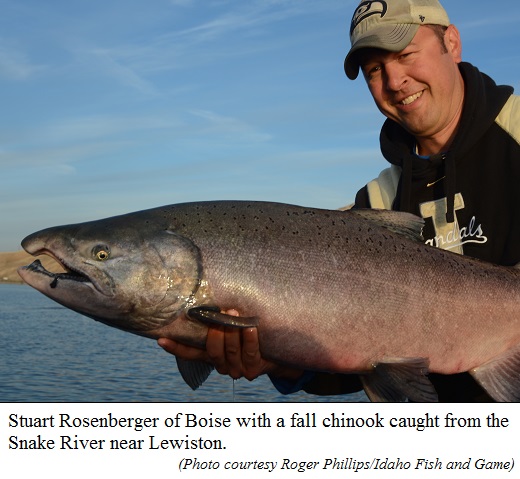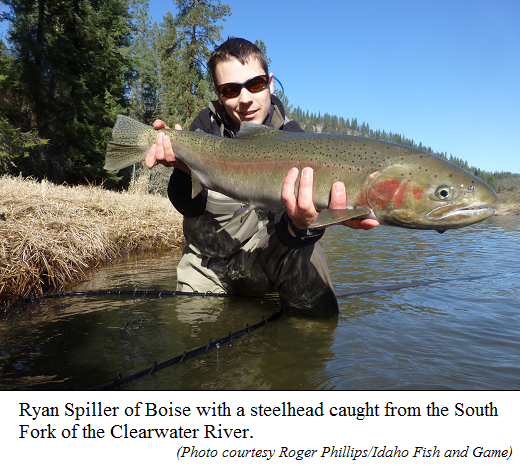|
|
|
Here is your basic starter information on
catching some of Idaho's biggest fish |
|
March 2, 2016 |
by Roger Phillips
Idaho Fish and Game
Want to catch big fish? Of course you do, and if
you want to consistently catch them, steelhead
and salmon are your best bets. Let’s look at the
tape, scale and ticker.
The average Idaho rainbow trout is around 10-14
inches and weighs about a pound. A trophy-size
rainbow is about 20 inches and weighs in the
4-pound range. A 30-inch rainbow is probably a
once-per-lifetime fish that weighs in the 10 to
15-pound range, although several northern Idaho
lakes consistently grow trout that large and
larger.
Now let’s look at steelhead. Steelhead are
rainbow trout that leave Idaho in the spring as
juveniles known as “smolts” and migrate to the
ocean, then spend about a year or two there
before returning as adults much larger than
trout.
The average-sized “A” run steelhead is between
23 and 26 inches and weighs 4 to 6 pounds. “A”
run steelhead are most common in the Snake and
Salmon rivers. Their larger cousins, the “B” run
steelhead, are found mostly in the Clearwater
River system, although some are also in the
Salmon and Snake rivers. The fish have a
different life history. “B” run fish spend two
or three years in the ocean and return much
larger, typically 31 to 34 inches and 10 to 13
pounds, but some are upwards of 20 pounds.
Big fish, big numbers
Over the last five years, an average of about
141,000 steelhead have returned to Idaho
annually.
Adult steelhead start returning to Idaho in late
summer and “winter over” in rivers before making
their push to the upper tributaries to spawn in
late winter and early spring. That gives anglers
roughly seven months to fish for them, and the
most popular times are during October and March.
Chinook salmon are even larger than steelhead.
They’re typically in the 12 to 15-pound range,
but chinook over 20 pounds are common. Over the
last five years, chinook returns to Idaho have
averaged about 134,000 fish. The first chinook
typically return to Idaho late March and early
April and are segregated into three categories:
spring, summer and fall runs.
So let’s do some quick math. In recent years,
Idaho got about 275,000 steelhead and chinook
annually, although run sizes vary from year to
year. Steelhead and chinook dwarf your average
trout and likely will exceed the largest trout
you catch in a given year, and possibly in your
lifetime.
Got your attention?
Unlike a once-per-lifetime trout, steelhead and
chinook are plentiful, reliable, predictable and
not difficult to catch. You need to have the
right gear, know a few basic fishing techniques
and know when to go.
You also need to know the basic rules. A full
set of rules and seasons can be found in the
current Idaho Fish and Game fishing rules
booklet, or online at
http://fishandgame.idaho.gov/. But a
critical thing to know is that only hatchery
steelhead and chinook can be harvested. You can
identify a hatchery fish by the clipped adipose
fin on the fish’s back directly in front of its
tail. If the full adipose fin is intact, you
have to release the fish unharmed. You will also
need a permit to fish steelhead and salmon in
addition to your fishing license.
(Story continues below this photo)

Timing is (almost) everything
March is prime time for spring steelhead fishing
and one of the best times for novice steelhead
anglers to give it a try. The fish migrate into
the smaller tributary streams, which means
there’s easy river access along highways and
lots of fish in the rivers. Some favorite
steelhead spots are the South Fork of the
Clearwater River upstream from Kooskia, the
Little Salmon River along U.S. 95 between New
Meadows and Riggins, and the upper Salmon River
along Idaho 75 and U.S. 93 between Salmon and
Stanley.
While you can be assured there will be ample
steelhead in these rivers during March and
April, river conditions can vary wildly
depending on rain or snow melt. Rivers can go
from low and clear to high and muddy within a
day or two.
As a rule of thumb, most anglers prefer to fish
for steelhead during spring when river
temperatures are in the mid-30s to low-40s.
Stable weather and consistent river flows tend
to produce the best fishing. But even if
conditions are imperfect, the fish are still
there, and you can catch them. It’s just going
to be more challenging.
Chinook start returning from the ocean in the
spring and typically reach Idaho during, or
shortly after, peak spring runoff. Fishing
usually starts lower in the Snake and Clearwater
rivers around Lewiston in late April and May.
Anglers follow the spring and summer chinook
upstream through their migration all the way to
the headwaters of the Salmon River near Stanley.
Fall chinook have a different life history. They
start arriving in late summer, and unlike spring
and summer chinook that spawn in headwaters,
fall fish spawn in the lower river systems,
mostly in the Snake River.
Gearing up to go
If you’re not used to tackling large fish, you
will probably need to invest in some new gear.
There’s a variety of steelhead and salmon rods
available, and you need a reel with a good drag.
Both steelhead and chinook fight hard, and they
are often hooked in strong river currents, so
you will want line suitable for the battle. Use
10 to 15 lb test for steelhead, and 15 to 20 lb
test for chinook. You may want to go heavier if
you’re fishing strong current.
Check with your local tackle shop or sporting
goods store to find suitable tackle, and
employees there can usually show you how to rig
for steelhead and salmon. You can also watch
several “How To” videos on popular methods used
for both steelhead and salmon, at Fish and
Game’s website on the pages for steelhead and
chinook under the “Fishing” tab.
Etiquette
Steelhead and salmon fishing are popular in
Idaho, and when the fish reach those smaller
tributary streams, the banks can get crowded
with anglers. Good etiquette means respecting
other anglers’ space, and also not being a “hole
hog” who takes over a popular fishing spot and
excludes others. Be assured there will be
competition for prime spots, but in most cases,
anglers have a good track record of working with
each other so everyone gets a fair chance at
hooking a fish. An educational video - Angler
Etiquette: Fishing with the Crowd - is available
on Idaho Fish and Game's website at
http://fishandgame.idaho.gov/fishing/etiquette.
The video covers commonly held practices in the
fishing community on fishing around others and
how to avoid potential conflicts.
The insider intel
There are several online tools anglers can use
to time their fishing trips during the prime
times when fish are there and conditions are
best:
Columbia Research Station’s “Dart”:
http://www.cbr.washington.edu/dart
This website compiles data about steelhead and
salmon and also tracks fish as they pass through
the Columbia and Snake River dams. You can get
daily counts at each dam, and also historic
timing when the runs typically go though each
dam.
USGS Streamflows:
http://waterdata.usgs.gov/id/nwis/current/?type=flow
This website gives you real-time stream flows
for most rivers in Idaho and water temperatures
at some gauging stations. You can also find
annual hydrograph charts that show when rivers
typically get peak spring run off.
Pit tag data:
http://www.ptagis.org/
This website provides information about fish
that are embedded with “pit tags,” which are
small transmitters. There are pit-tag detectors
in some Idaho streams, and anglers can use them
to track the steelhead and salmon as they move
upstream.

|
|
|
|
Questions or comments about this
article?
Click here to e-mail! |
|
|
|
|

